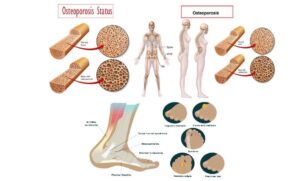All over the world, people are affected by overweight and obesity which lead to more cases of non-communicable diseases (NCDs). The review looks at the most common conditions people with extra weight may suffer from, for instance, cardiovascular diseases, diabetes, some types of cancer, muscle problems, breathing difficulties and others.
A lot of global regions have high rates of being overweight or obese. In 2022, based on research by the World Health Organization (WHO), 1 billion people worldwide were found to be living with obesity: this included 39 million children, 340 million adolescents and 650 million adults.
Lack of exercise, an unhealthy eating pattern and genetics lead to more such cases.
Researchers, public health experts, policymakers and individuals must know about the different illnesses related to being overweight.
1. Conditions related to Cardiovascular Diseases (CVDs).
Coronary Artery Disease
A common condition is when the walls of your arteries harden which can lead to Coronary Artery Disease. When a person is overweight, they have a greater chance of getting atherosclerosis, a condition where cholesterol deposits in the arteries and may bring about coronary artery disease (CAD), ending in myocardial infarction (heart attack). Obesity is a risk factor for high blood pressure, too high LDL or triglycerides and inflammation which all contribute to form arterial plaque. Learn how effective weight management can help prevent these diseases.
Mechanism:
Visceral fat in the body secretes pro-inflammatory proteins (like TNF-α and IL-6) that harm the walls of blood vessels, causing resistance to insulin and more harm to the heart.
Hypertension
Overweight causes increased blood flow and makes your heart work harder which exerts pressure on blood vessels and raises blood pressure. The Framingham Heart Study implies that two-thirds of women and three-quarters of men who get hypertension do so because of being overweight.
2. Type 2 Diabetes Mellitus (T2DM).
Obesity is the leading reason for developing type 2 diabetes mellitus (T2DM). Since the connection between the two is so powerful, the term “diabesity” is used for obesity and diabetes together.
Pathophysiology:
Extra fat in the body disturbs the liver and muscle tissues respond to insulin which causes insulin resistance. In the beginning, the pancreas makes more insulin to normalize blood sugar levels, but due to β-cells dysfunctioning, the pancreas cannot produce enough insulin and glucose starts to increase.
The Lancet published a study revealing that having a high body mass index leads to more than half of all disability-adjusted life years (DALYs) due to type 2 diabetes each year.
3. Certain Cancers
Risk factors for certain cancers now include overweight and obesity.
- Colorectal cancer
- Breast cancer (occurring in women after menopause)
- Endometrial cancer
- Pancreatic cancer
- Kidney and liver are common types of cancer.
Mechanisms:
- Severe inflammation that stays for a long time.
- Increased insulin and insulin-like growth factor-1 (IGF-1)
- Problems with leptin and adiponectin can contribute to obesity because these are adipokines.
4. Musculoskeletal Disorders
Osteoarthritis (OA)
OA mainly affects the knees, hips and lower back bones which carry a lot of body weight. Being overweight results in more strain on the joints and at higher risk of cartilage breakdown.
Gout
Being overweight increases the chances of having hyperuricemia which is a significant cause of gout, a painful type of arthritis. Impaired kidneys limit uric acid excretion which is then made in excess by the breakdown of fat tissue.
5. Respiratory Disorders
Obstructive Sleep Apnea (OSA).
OSA affects many obese people. Extra weight in the neck and upper airway clogs the airway while sleeping.
Consequences include:
Daytime fatigue
A greater risk of hypertension.
Risk to develop heart disease
Having obesity is the biggest risk for OSA and putting on just 10% more weight can make the condition six times more likely.
Asthma
Dealing with obesity can make asthma more likely or worse by a number of processes.
- Reduction of the amount of air in the lungs
- When there is inflammation in the airway
- Immune systems that do not work properly
6. Non-Alcoholic Fatty Liver Disease (NAFLD).
Chronic liver disease in developed countries is most often caused by NAFLD. The disease ranges from a mild fat development in the liver (steatosis) to more advanced conditions known as non-alcoholic steatohepatitis (NASH) and cirrhosis.
7. Reproductive Disorders
This syndrome is known as Polycystic Ovary Syndrome (PCOS). About 5–10% of women who are able to have babies are affected by PCOS which is marked by too much male hormone in the body, irregular periods and ovaries with lots of small cysts. Obesity heightens insulin resistance which is a main characteristic of PCOS. Obesity heightens insulin resistance which is a main characteristic of PCOS. “BMI Calculator ,Ideal Body Weight Calculator,Water Intake Calculator can help support overall health and manage PCOS effectively.
Male Infertility
When men are obese, their ability to reproduce can be lowered by changes in how much testosterone is produced.
Diet Table for Obesity and Related Diseases
| Disease / Condition | Meal Tips |
| Obesity (General) | Portion control, low-calorie dense foods, water before meals |
| Type 2 Diabetes | Low glycemic index (GI) diet, avoid skipping meals |
| Cardiovascular Disease | DASH or Mediterranean diet, reduce salt intake |
| Non-Alcoholic Fatty Liver (NAFLD) | Include antioxidants like vitamin E and polyphenols, avoid late-night eating |
| Polycystic Ovary Syndrome (PCOS) | Balanced carbs with protein, 3 main + 2 small meals daily |
| Osteoarthritis & Gout | Anti-inflammatory foods, hydration, low-purine diet (for gout) |
| Sleep Apnea & Asthma | Light evening meals, avoid heavy/dense foods before bed |
| Depression & Anxiety (obesity-linked) | Regular mealtimes, mood-boosting nutrients (B6, B12, folate, magnesium) |
Additional Guidelines
- Try to drink 2–2.5 liters of water each day.
- Most people should have 3 balanced meals and ideally 1–2 healthy snacks each day.
- Plate Portion: Eat on a smaller plate; limit yourself to just one helping.
- Steaming, grilling and baking are preferred over fried and sautéed.
- Get 150 minutes each week of additional moderate physical exercises.
- Mindful eating, logging what you eat and improving how you fall asleep are all very important.
Conclusion
You may see obesity as just a weight problem but it can lead to heart conditions, diabetes, liver issues and hormone balance. A balanced diet, healthy lifestyle and knowledge can be enough to keep you from developing health issues or even fix existing ones. Fitness is not just about appearance; it helps you live a longer, better, happier life! Immediately build an individual, balanced eating plan and choose healthy options. Fitness is not just about appearance; it’s about living a longer, healthier, and happier life! Build your individual balanced eating plan today and start choosing healthy options that truly work for you.






